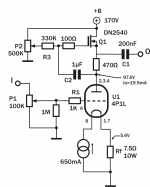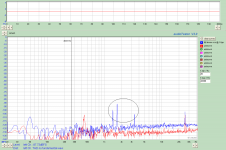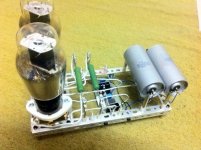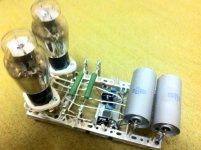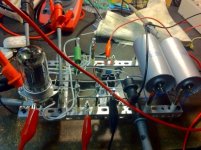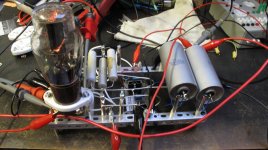Breadboarded preamp attached. This valve in triode mode is really linear. You can get down to 0.01% when anode current is about 40mA!
My tests were done with Vi=1Vrms. At Va=97.6V and Ia=19.89mA the THD is 0.05%, much better than an average 26 though. Gain stage is about 9.5 in this circuit.
Now need to build a pair of these and build the preamp to do a proper listening test. I can't wait to listen to results and hopefully not end up with a ringing preamp!
My tests were done with Vi=1Vrms. At Va=97.6V and Ia=19.89mA the THD is 0.05%, much better than an average 26 though. Gain stage is about 9.5 in this circuit.
Now need to build a pair of these and build the preamp to do a proper listening test. I can't wait to listen to results and hopefully not end up with a ringing preamp!
Attachments
Looks nice, except R3 that you can increase significantly.
I hope it will not ring... Crossing fingers!
I hope it will not ring... Crossing fingers!
Yup, R3 can be as high as 10M!
I regularly use 4.7M in that position and 0.1uF (C2 in your scheme) from anode to GS of MOSFET....
I regularly use 4.7M in that position and 0.1uF (C2 in your scheme) from anode to GS of MOSFET....
I have in mind one more candidate to replace 4P1L. More convenient in terms of filament, because it is indirectly heated, but very similar to 4P1L by parameters.
I have in mind one more candidate to replace 4P1L. More convenient in terms of filament, because it is indirectly heated, but very similar to 4P1L by parameters.
Oh yes....
Do Tell!
The main objection I had to the 4P1L was the ringing michrophony of the Direct-heater!
Oh yes....
Do Tell!
The main objection I had to the 4P1L was the ringing michrophony of the Direct-heater!
Please wait 2 days until the auction on epay ends... 😉
I want to buy and try them before.
I just built a 26 preamp. It definitely has something special, but nowhere near as clear as 4p1l preamp. I am off to India for a month in a few minutes. When I get back, I will complete my //4p1l power amp then optimise and compare the 26 and 4p1l preamps side by side. Should be an extremely revealing test.
Speak later,
William.
Speak later,
William.
Hi William, That is exactly what I'm going to do. My 26 pre-amp is superb but hope that the 4P1L is up for the challenge!
Cheers,
Ale
Cheers,
Ale
Did an audio test with my breadboard preamp and results as expected:
1) The sound is crystal clear and dynamics are superb. Great bass response. Everything you would ask of a preamp. Still need to do a side by side comparison with the 26. Although this preamp version is powered from my bench power supply and has no filament regulators.
2) It rings indeed. Oh man, many said so and it's true. Not that critical though. The ringing is very low and in my breadboard I have to tap with the back of my screwdriver to get the ringing out loud. It develops some harmonics around 1.3 - 1.6kHz and decay is quite fast. See attached FFT
After listening to Dvorák for 15 mins on my workbench with this preamp have to say that sounds really nice. I take that the ringing will colour the sound, but I wasn't able to notice it so far in the breadboard.....
More tests to follow...
Cheers,
Ale
1) The sound is crystal clear and dynamics are superb. Great bass response. Everything you would ask of a preamp. Still need to do a side by side comparison with the 26. Although this preamp version is powered from my bench power supply and has no filament regulators.
2) It rings indeed. Oh man, many said so and it's true. Not that critical though. The ringing is very low and in my breadboard I have to tap with the back of my screwdriver to get the ringing out loud. It develops some harmonics around 1.3 - 1.6kHz and decay is quite fast. See attached FFT
After listening to Dvorák for 15 mins on my workbench with this preamp have to say that sounds really nice. I take that the ringing will colour the sound, but I wasn't able to notice it so far in the breadboard.....
More tests to follow...
Cheers,
Ale
Attachments
Hi!
With some directly heated triodes, microphony can be reduced by lowering the filament voltage. Expecially the 801A and 10Y benefit from that. I operate the filaments of 801As in preamps around 6.5Vs
Might be worth a try
Thomas
With some directly heated triodes, microphony can be reduced by lowering the filament voltage. Expecially the 801A and 10Y benefit from that. I operate the filaments of 801As in preamps around 6.5Vs
Might be worth a try
Thomas
Now trying a 6P21S triode strapped at Ia=15.5mA and Va=142V. Rfil is 10 ohms so Vgk=-8V at 800mA. THD is around 0.2%
No ringing, nice and warm sound. I like it quite a lot though....
No ringing, nice and warm sound. I like it quite a lot though....
Hi!
With some directly heated triodes, microphony can be reduced by lowering the filament voltage. Expecially the 801A and 10Y benefit from that. I operate the filaments of 801As in preamps around 6.5Vs
Might be worth a try
Thomas
Hi Thomas,
Didn't know that! Will rebuild breadboard later and test 4P1L again. How much can you lower the voltage, 10%?
One way to lower the voltage nicely is to feed the filament with a CCS like Rod's supply or the supply I showed earlier, which will have a means to adjust the current. Simply run slightly less current through the filament.
Here's some data:
http://greygum.net/sbench/sbench102/dht.html
Here's some data:
http://greygum.net/sbench/sbench102/dht.html
Finished now my modular breadboarded pre-amp and now tested the 46/VT-63 and was amazed with the results!
Quiescent point at Ia=11mA / Va=100V (Vgk=-8.8V - filament bias) where the stage gain is around 6 and the THD=0.16%. Surprised with the linearity of the 46.
Andy Evans recommended it before and he was right, it sounds really good.
Still running this setup with my bench power supplies and am amazed with the results so far.
Still listening to Dvorák (Concert for violoncello) and enjoying the full bass, warm and clarity of this stage circuit...
Quiescent point at Ia=11mA / Va=100V (Vgk=-8.8V - filament bias) where the stage gain is around 6 and the THD=0.16%. Surprised with the linearity of the 46.
Andy Evans recommended it before and he was right, it sounds really good.
Still running this setup with my bench power supplies and am amazed with the results so far.
Still listening to Dvorák (Concert for violoncello) and enjoying the full bass, warm and clarity of this stage circuit...
Attachments
Now went back to the 4P1L, and tried recommendations from Iko and Thomas.
I reduced filament current by 40% to 394mA. That's the lowest point that minimises distortion in the 4P1L. Then readjusted bias to Ia=17.7mA and Va=102V. THD went down to 0.018%!
Ringing was significantly reduced with this and you need to turn the volume up and tap it to hear it
Looking good...
I reduced filament current by 40% to 394mA. That's the lowest point that minimises distortion in the 4P1L. Then readjusted bias to Ia=17.7mA and Va=102V. THD went down to 0.018%!
Ringing was significantly reduced with this and you need to turn the volume up and tap it to hear it
Looking good...
Attachments
Sound is nice indeed. Interesting to see when you reduce filament current it changes also the harmonic distribution. Second harmonic reduces whilst you get a bit of the third..
It may be a good idea to suspend the base of the 4P1L to reduce microphonic feedback?
I need to finish this up to take it down to the room where the 45 SE and 26 pre-amps are. Will do a proper side by side comparison 🙂
More testing to follow...
Thanks for the help!
It may be a good idea to suspend the base of the 4P1L to reduce microphonic feedback?
I need to finish this up to take it down to the room where the 45 SE and 26 pre-amps are. Will do a proper side by side comparison 🙂
More testing to follow...
Thanks for the help!
Some more tests today. Tried CX112a and 01A (RCAs globes). Both sounds very nice, warm and good bass. However, didn't like them as the 46 or 4P1L. Slightly microphonic and higher distortion levels (0.40% for 01A). Don't have many 01As, so it may be the quality of the ones I have.
I tried also running them at a lower current and although I noticed a good improvement on the CX-112a (distortion is minimum at If=160mA), then didn't experience the same results with the 01A. You have to watch out when filament current is reduced that the third order harmonic starts to increase slightly. I couldn't perceive any audible difference.
Finally I did a test with an RCA 10Y. This is a lovely valve!
My optimised quiescent point is Va=250V/Ia=8.79mA and filament current is reduced to 1.015A to achieve minimum distortion. THD is 0.06% when loaded. No microphonics, and sounds really warm, bright and great bass response as well.
Still playing Dvorák concert for violoncello. It has some great passages with lots of dynamics to listen to the pre-amp response.
The 10Y is a challenge for filament bias. You need around 22W per valve just for the filaments! I used three 51 ohm Russian resistors in parallel that Andy Evans gave me and they do get hot!
I think that the 10Y is a challenge to the 26 pre-amp and so does the 4P1L . Specially if you consider the cost.
Overall, I impressed with the performance of the gyrator-loaded stage. My 26 preamp has a LL1660, which is superb. However, a cost-effective gyrator in mu-follower configuration and a good output capacitor is fantastic
I tried also running them at a lower current and although I noticed a good improvement on the CX-112a (distortion is minimum at If=160mA), then didn't experience the same results with the 01A. You have to watch out when filament current is reduced that the third order harmonic starts to increase slightly. I couldn't perceive any audible difference.
Finally I did a test with an RCA 10Y. This is a lovely valve!
My optimised quiescent point is Va=250V/Ia=8.79mA and filament current is reduced to 1.015A to achieve minimum distortion. THD is 0.06% when loaded. No microphonics, and sounds really warm, bright and great bass response as well.
Still playing Dvorák concert for violoncello. It has some great passages with lots of dynamics to listen to the pre-amp response.
The 10Y is a challenge for filament bias. You need around 22W per valve just for the filaments! I used three 51 ohm Russian resistors in parallel that Andy Evans gave me and they do get hot!
I think that the 10Y is a challenge to the 26 pre-amp and so does the 4P1L . Specially if you consider the cost.
Overall, I impressed with the performance of the gyrator-loaded stage. My 26 preamp has a LL1660, which is superb. However, a cost-effective gyrator in mu-follower configuration and a good output capacitor is fantastic
Attachments
Last edited:
Running 10Y at 16.8mA/295V distortion is reduced to 0.012%. Sounds is brilliant, but what an expense in power for a line stage
- Home
- Amplifiers
- Tubes / Valves
- 4P1L DHT Line Stage
